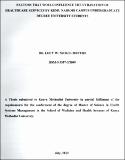Factors that would influence the utilization of healthcare services by KeMU Nairobi campus undergraduate degree university students.
Abstract
The Kenya healthcare system has been making varied efforts towards improvement. Utilisation of healthcare services continues to be a concern, with the need for
interventions that can strenghthen the current weaknesses. Accepted models of healthcare service utilisation may not apply to university students due to their unique socio-demographic characteristics and health challenges. This study focussed on the service delivery pillar of health systems. The absence of a healthcare facility in KeMU-Nairobi campus that can cater for the healthcare needs of the students, remains a weakness in the service delivery pillar and hence an area that needs strengthening. The purpose of this study was to establish the factors that would influence the utilisation of healthcare services by undergraduate degree students if a facility were to be availed at the campus. The Andersen and Newman framework (1995) of health service utilisation was used as the theoretical framework. The objectives were to investigate the need, enabling and predisposing factors that influence the utilisation of healthcare services by undergraduate degree university students at KeMU Nairobi Campus. This was a cross-sectional study with qualitative and quantitative aspects. Random sampling was used to select respondents from the various degree courses. Systematic sampling was used to arrive at the required sample size. Respondents were 390 undergraduate degree university students at KeMU Nairobi Campus. Data was collected using pre-structured and pre-tested questionnaires. Data was analysed using a logistic regression mode of analysis which was done using SPSS version 17. The undergraduate degree student utilisation model designed by this study established nine predictors of utilisation of healthcare services by this target group. These were: need factors - awareness of services offered by the institution, purpose of utilising healthcare services; enabling factors — location of a healthcare facility, availability of healthcare services and source of income; predisposing factors — gender, marital status, academic performance, and interruption of academics due to health related reasons. The respondents had a 1.4 chance of utilising healthcare services if they were aware of the existence of the services and the facility; 78% of the respondents sought services when sick or in the event of an emergency; 63% of the respondents were concerned about the availability of health services; those who were self employed had an odds ratio of 0.32 of utilisating healthcare services; 61% of the respondents were female; 73% of the respondents were single; 52% of the respondents were students who got at least a grade of B+ and above; and 92% of the respondents had their studies interrupted due to healthcare related reasons. Conclusions of this study were that the students' population would specifically seek healthcare services when sick or in the event of an emergency; location was a key influence of utilisation of healthcare services; those who were not married had a higher chance of seeking healthcare services, and were not particular about which type of physician they saw. This study recommended that deliberate efforts must be made to create awareness of services that would be offered at the healthcare facility that would be established for the students population at KeMU Nairobi campus; the healthcare facility should be located in an area that can be easily accessed by the student population; and that there should be training and counselling services offered on student-work-life balance at the healthcare facility that would be set-up for the students.
Publisher
KeMU

